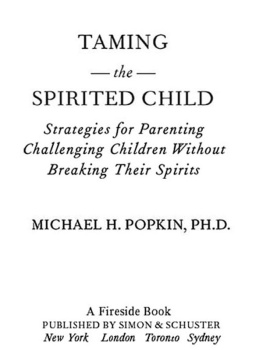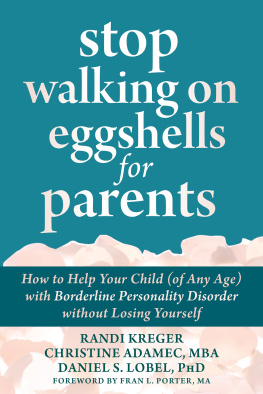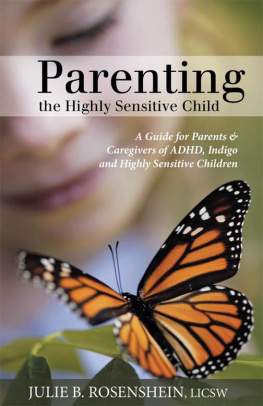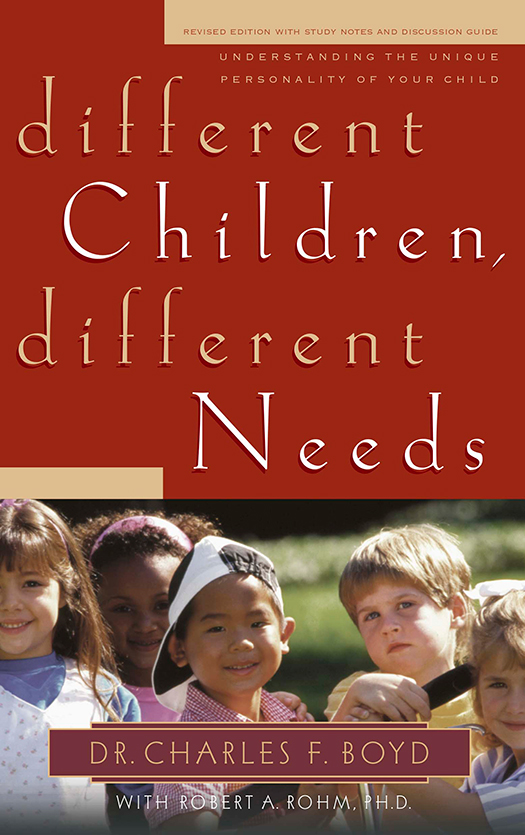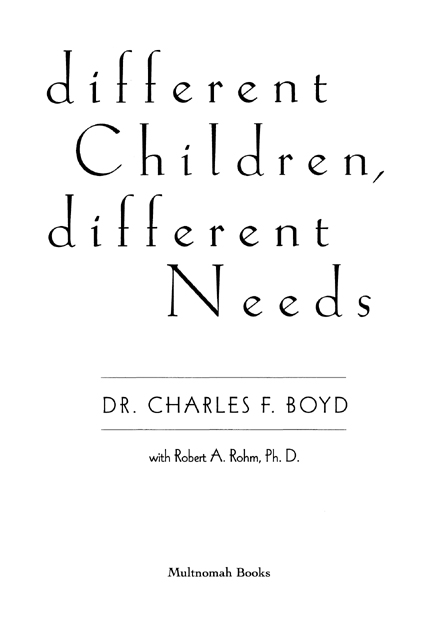Different Children, Different Needs is one of the most comprehensive manuals Ive read on parenting. It is easy-to-understand reading which follows a hands-on, do-as-you-read format, enabling the reader to learn new parenting methods and procedures in a step-by-step process. The results are a better understanding of ourselves as parents, as well as our children with their many differences and distinctions. Charlie Boyd ties all of the information to basic how-tos which are practical and enlightening. I believe this book will make a positive difference in families that care enough to apply what it teaches.
Z IG Z IGLAR , CHAIRMAN , Z IG Z IGLAR C ORPORATION
One of the most common mistakes we make as parents is to assume that our children are just like me. A father who enjoys leadership and taking risks, for example, may be frustrated with a son who is cautious and moves at a slower pace. Different Children, Different Needs offers practical help for any parent to truly understand how their children behave and then make adjustments to meet their unique needs. This book will help you look at your children in a totally different way.
D ENNIS R AINEY , EXECUTIVE DIRECTOR , F AMILY L IFE
God created each child with a specific bent. Charlie Boyd will help you discover that bent and assist you in helping your children fulfill their God-ordained destiny.
D R . S TEVE F ARRAR , AUTHOR OF THE BESTSELLER P OINT M AN
Ive had the privilege of knowing Charlie Boyd for years, and watching him develop an outstanding ministry to parents across the country. Now hes taken many of those tested principles and created a powerful tool for building close-knit familiesDifferent Children, Different Needs. If youre ready to decrease distance in your home, and to increase closeness, insight, and communication, this book is for you.
J OHN T RENT , PRESIDENT , E NCOURAGING W ORDS
Each of us as a parent can get rattled just dealing with the different personalities in our kids, let alone understanding how to adequately meet their individual needs. Different Children, Different Needs beautifully articulates the incredible value of those differences, providing answers in adapting our parenting styles around each child. We highly recommend this bookthere is nothing on the market like it!
D R . G ARY AND B ARBARA R OSBERG ,
FOUNDERS , A MERICAS F AMILY C OACHES
AND AUTHORS OF T HE F IVE L OVE N EEDS OF M EN AND W OMEN
DIFFERENT CHILDREN, DIFFERENT NEEDS
Revised Edition
published by Multnomah Books
1994, 2004 by Charles F. Boyd
Unless otherwise indicated, Scripture quotations are from:
The Holy Bible, New International Version
1973, 1984 by International Bible Society, used by permission of Zondervan Publishing House
Other Scripture quotations are from: New American Standard Bible ( NASB )
1960, 1977 by the Lockman Foundation
Published in the United States by WaterBrook Multnomah, an imprint of the
Crown Publishing Group, a division of Random House Inc., New York.
M ULTNOMAH and its mountain colophon are registered trademarks of Random House Inc.
ALL RIGHTS RESERVED
No part of this publication may be reproduced, stored in a retrieval system, or
transmitted, in any form or by any meanselectronic, mechanical, photocopying,
recording, or otherwisewithout prior written permission.
For information:
MULTNOMAH BOOKS
12265 ORACLE BOULEVARD, SUITE 200
COLORADO SPRINGS, CO 80921
Library of Congress Cataloging-in-Publication Data
Boyd, Charles F. (Charles Franklin), 1954
Different children, different needs: understanding the unique personality of your child by Charles F. Boyd with Robert A. Rohm, Ph.D. p. cm.
Includes bibliographical references (p.) and index.
eISBN: 978-0-307-56874-8
1. Child psychology. 2. Child rearing. 3. Individual differences in children.
4. Typology (Psychology). 5. Parenting. I. Rohm, Robert A., Ph.D. II. title.
HQ772.B6437 1994
9421370
649.1dc20
v3.1_r1
To my parents, Frank and Betty Boyd
who let me be myself.
To my wife, Karen,
who is helping me become more than I could ever be alone.
And to my children, Chad, Kristi, and Callie,
who I pray will benefit most from the material in this book.
Contents
A PPENDIX A:
Forty Behavioral Strengths You Can Mirror to Your Child
A PPENDIX B:
Summary of the DISC Model
A PPENDIX C:
Recommended Resources
Preface
THIS IS NOT A BOOK. Oh, I know it looks like a book and feels like a book. But I would like to ask you not to think of it as a book; at least, not the way you think of most other books.
Most books are read and then put back on the shelf. They inform and entertain, but after they are read, they are forgotten. Even the advice in how-to books is often ignored. Used bookstores are full of books that people felt were no longer valuable enough to keep.
I hope it will be different with this one. The contents of the following pages can shape your thinking about your job as a parent in ways you may not expect. Its my prayer that when you finish the last page you will not be the sameor, at least, you wont think in the same wayabout your mate, your children, your parents, or anyone else. This material had that kind of impact for me and my wife, Karen, and Ive seen it do the same time and again in the lives of those who attend parenting or marriage seminars that present what you are about to read.
Now, this is not the last book on parenting youll ever have to read. Far from it. There are many things you need to know about parenting that are not mentioned in this book. Ive included a resource section in the back to help you as you seek to equip yourself to become a better parent.
But Different Children, Different Needs lays a key foundation. Based on the biblical teaching of Proverbs 22:6, the principles in this book can become the backbone for everything you do as a parent. If you dont practice the big picture principle that is presented in the following pages, your kids will be negatively affected. But if you take Proverbs 22:6 seriously and seek to apply what you find in this book, your children will come to understand how God has designed and gifted them. They will grow to have both a sense of confidence and a sense of belonging.
FOR DISCUSSION GROUPS
Why not invite a small group, class, or other circle of friends to read this book with you? Your agenda can follow a very simple format.
As you read the suggested chapters for each session, underline or highlight words, phrases, or sentences that speak to you. Write notes in the margins along with questions, comments, disagreements, and additional insights.
Also, reflect on stories and examples from your family life, past and present, that illustrate the principles or problems discussed in the chapter.
When your group gets together, share your underlinings, annotations, and illustrations. Take turns answering these two questions: What is something in this chapter that really spoke to you? Why?
After everyone shares, answer another group of questions: So what? What difference should what we have talked about make in the way we relate to our children? What will you do differently, tomorrow or in the coming week or month, based on what you have read and discussed?




